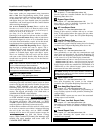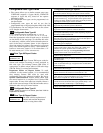
Configurable Zone Type Fields
• The system allows you to define custom zone types
(VISTA-20P supports 4 [types 90-93]; VISTA-15P
supports 2 [types 90, 91]), based on the options
described at right.
• All configurable zone types can be programmed via
the downloader.
• Configurable zone types 90 and 91 can also be
programmed from a keypad using data fields *182-*185.
UL installations: Do not configure zones as fire alarm
or UL burglar alarm zones.
*182
Configurable Zone Type 90
0-15 = values for each of 10 entries
(0-9, # + 10 = 10,
# + 11 = 11, # + 12 = 12, # + 13 = 13, # + 14 = 14, # + 15 = 15
)
Enter the appropriate value for each entry, 1-10, based
on the charts on the next page.
To calculate the value
for each entry, add the values of the selected options in
each of the entry’s columns shown in the respective
chart (one option per column). For example, to program
entry 2 for “alarm response to short,” “auto restore on,”
but not a “vent zone,” enter 5 (“1” for alarm short + “4”
for auto restore-yes + “0” for vent zone-no).
*183
Zone Type 90 Report Codes
90 ALARM ID: XXX
TROUBLE ID: XXX
Enter the desired 3-digit Contact ID® report codes for
alarms and troubles occurring on zones assigned to
this zone type. Use existing Contact ID® codes, if
appropriate, or define unique codes in CID code range
750-789. Press [∗] to accept and continue.
Important Notice on Report Codes: To avoid
confusion at the central station, it is recommended
that existing Contact ID® codes be used with
configurable zone types whenever possible. See list in
System Communication section and/or check with
the central station for a complete list of Contact ID®
report codes. If none of the codes are suitable, choose a
code in the reserved range of 750-789 and make sure to
define the code with your central station.
*184
Configurable Zone Type 91
0-15 = values for each of 10 entries (see field *182 for
explanation of entries.)
*185
Zone Type 91 Report Codes
91 ALARM ID: XXX See field *183 for explanation of
TROUBLE ID: XXX entries and read the Important
notice on using these codes.
Configurable Zone Type Options
Auto Restore (entry 2): Faults on zones set for this option
are cleared; restore messages sent upon restoral of faults.
Vent Zone (entry 2): Zones set for this option are ignored if
faulted when arming the system, but are protected if the zone
is later restored (e.g., an open window can be ignored when
arming, but if the window is later closed, it will be protected;
opening the window again causes an alarm.)
Bypass Disarmed (entry 4): Zones set for this option can be
bypassed only while the system is disarmed.
Bypass Armed (entry 4): Zones set for this option can be
bypassed when the system is armed or disarmed.
Dial Delay (entry 6): Alarms on zones set for this option
participate in dial delay central station reporting, if system
dial delay enabled in field *50.
Fault Delay (entry 6): Faults on zones set for this option are
delayed by the time set in field *87. Do not use this option if
using entry/exit delay for this zone type.
Faults Display (entry 7): Selects how faults on zones set for
this zone type are displayed.
Power Reset/Verification(entry 7): Selects whether the
system resets power (when user enters code + OFF), and
whether the system performs alarm verification (see
description for zone type 16 in Programming Overview
section) when a fault occurs on these zones.
Use Entry Delay (entry 8): Selects whether to use the
system’s entry delay times.
Use Exit Delay (entry 8): Selects whether to use the system’s
exit delay time.
Interior Type (entry 8): Zones set for this option are treated
same as standard zone type 4 (bypasses when armed STAY,
faults displayed).
Alarm Sounds (entry 9): Selects the type of alarms sound for
zones set for this zone type.
Bell Timeout (entry 9): Alarm sounding on zones set for this
option remain for the duration set in fields *32 / *33.
Fire Zone (entry 9): Zones set for this option respond in the
same manner as if programmed for zone type 9. Do not set
fire zones to respond as a “fault” in entries 1-6.
Trouble Sounds (entry 10): Selects the type of trouble
sounds for zones set for this zone type (periodic beeps = once
every 30 seconds; trouble beeps = rapid beeping).
Chime Enable (entry 10): Zones set for this option cause a
chime when Chime mode is on.
Data Field Programming
4-9


















